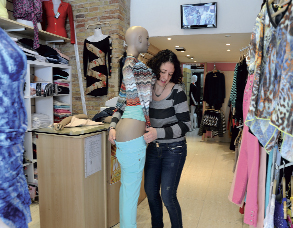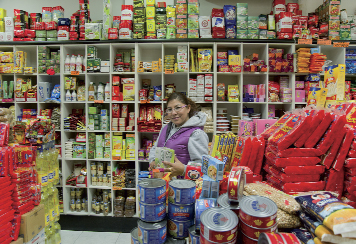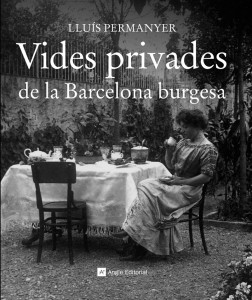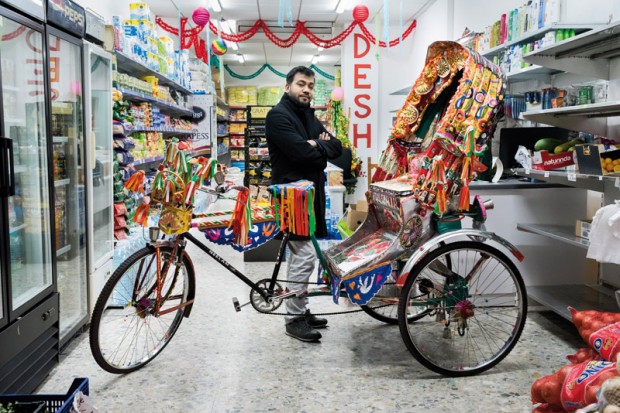
Abdullah al Mamun (Shafiq), owner of the Galiza tavern and organising secretary of the Bangladesh Cultural and Humanitarian Association, photographed in a fellow countryman’s establishment, on the border between the Raval and Sant Antoni neighbourhoods.
Photo: Dani Codina
Except for the Chinese and the Italians, the volume of immigrants in Barcelona has stabilized, and many people —largely as a result of the recession and the rise in the cost of living— have decided to move to another town or to return home. Under these circumstances, other nationalities that had not been as well-represented have become more visible, like the Bengalis, the Armenians or Hondurans.
“I remember that in the beginning, there were 35 of us. Now there are 4,000.” In 1985, when Nabinul Haque came to Barcelona at the age of 22 and began to serve coffees at the old Cinema Catalunya —where El Triangle shopping centre is today— he had already spent six years working in France and Germany. Three more decades have had to pass for thousands of Bengalis from Dacca (his home town), Chittagong (in the East) and Sylhet (in the rural Northeast) to decide to follow his example: set out for Barcelona and, once established with guarantees of being able to stay, bring their wife and children. His son, who was apprenticing to make cocktails in Miami, is the one that encouraged him to sell the supermarket he had on El Paral·lel and open up the restaurant-lounge Ébano nearby, serving a fusion of Indian and Mediterranean food. Other compatriots have also sought to adapt to the culinary preferences of the local population, like Abdullah al Mamun (Shafiq), owner of the Galiza tavern, whose menu doesn’t include either danbauk —rice with curry and chicken— or red lentils (masoor dal).
Abdullah serves as organizing secretary of the Cultural and Humane Association of Bangladesh, which seeks to strengthen ties with Catalonia. One Sunday in April he puts this into practice at the Plaça dels Àngels, where he celebrates Pohela Boishakh— his new year. Hundreds of natives come together to sing, dance and offer neighbours and passers-by traditional products. No less colourful are the activities organized by the Association of Women from Bangladesh in Catalonia, which provides an opportunity to get to know some traditional holidays like Pitha Utshob, the welcoming of winter, or the commemoration of independence on March 26 (Shadhinôta Dibôs). For Mehetal Haque, president of the organization and a native of Nabinul, these are opportunities to show that they aren’t “as closed-off as it seems.”
The desire to integrate into Catalan society isn’t in conflict with the defence of their own culture, which is why on Fridays and Saturdays, Bengali is taught to children and young people at the Sant Antoni Piarist school. This ancient language, the sixth most spoken in the world, plays an important role in the history books. On February 21, 1952, thousands of people protested in the capital, Dacca, in favour of the language rights of the people, and Pakistan —which controlled the territory from the time of the partition of India and had imposed Urdu as the only official language— responded with a massacre. On that day, declared International Mother Language Day by UNESCO, the Bangladeshis of Barcelona take to the streets once again to remember, to leave an offering at the monument placed in front of the MACBA, and to sing Amar sonar bangla (the national anthem, with lyrics by poet Rabindranath Tagore) all together to the sound of harmoniums.
You don’t need to know how to read in Bengali to recognize its alphabet. By looking at the signs over businesses, we can determine where most Bengalis live. I recommend taking Carrer de la Cera to the area of El Pedró in El Raval: there’s Bazaar Aalif, Bangla Spice Bar, the Malik and Naba Express groceries (yes, the sign says “products from the Philippines and Thailand”)… A business on Carrer de la Botella sends money and recharges mobile phones, and other convenience stores in the area are open until the early morning hours. The Sunni Muslims from Bangladesh head to Shah Jalal Jame Mosque on Carrer de la Riereta on a daily basis, and many of the men wear the typical headgear (tupi). If they go at all, their wives (who pray separately) go on Sundays, with their entire bodies covered with a traditional shalwar kameez garment. All other times, and in contrast to the Pakistanis, they all wear western clothing.
On busier streets like the Ronda de Sant Pau, business is aimed more at tourists. At La Alhambra, El Diamante and Kalab Ghar, Turkish specialties and paellas are served. On La Rambla del Raval, although it may seem surprising, Istanbul Kebab, Fragua Grill, Toscana Italian restaurant and La Reina del Raval are owned by Bengalis. However, the best reviews are for Tandoori Nights on Carrer de les Carretes, maybe because the Indian food there is quite a bit more familiar to the Bengali cooks than dürüms or potato omelette.
Sons of the diaspora
If there is one place that has been abused by history, it is shrunken Armenia, invaded by Romans, Byzantines, Persians, Ottomans and Russians. Cut off from access to the sea and with an impoverished economy, its inhabitants have participated in one of the greatest diasporas of the modern era. It has been calculated that 8 million Armenians live outside of Armenia; in Barcelona, there are a few thousand. Here, many have found a breath of fresh air, where they can get back on their feet economically and prosper professionally. This is the case of Babken Karaxjan, who can often be seen on the benches of Via Júlia, playing cards with some of his countrymen. These are people who arrived at the end of the ‘90s and who have experienced hard times, taking on harsh jobs or, in some cases, even sleeping on the street. With later legislative reforms, many were able to get papers; their situation improved, and they were able to bring their families over.
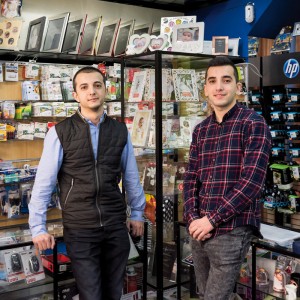
The brothers Frunz and Tigran Manukyan run a photography and information store on the Verdum promenade.
Photo: Dani Codina
Martik Matinyan, who is 46 years old and has two university degrees, lived for a time in St. Petersburg and didn’t even consider returning home: “a country surrounded by Muslim countries where food has to be brought in by airplane had nowhere to go but down”, he declares. He liked Barcelona and Barça, and he decided to try his luck as a construction businessman; he did fairly well until the recession came. Now he’s in charge of a laser paintball space, and when he can he helps out his compatriots. He encouraged brothers Frunz and Tigran Manukyan to reopen a photography store on Passeig de Verdum, which is lately more about computers. Across the street Hayastan Olympic wrestling opened up; there, the European champion of Greco-Roman wrestling Movses Karapetyan and his son teach a sport that is just as popular as chess in the Caucasian republic.
Before any other nation, in 301 Armenia declared Christianity its official religion, and founded its own church. Although the Armenians living in Barcelona identify with this religion, they don’t practice it frequently, and only a handful attend the mass held once a month for them at the parish Church of Mare de Déu dels Àngels. Some other important dates are September 21 —Independence Day— where the Armenian Cultural Association of Barcelona organizes recreational activities, and especially April 24, when the genocide committed by the Turks in 1915 is commemorated with gatherings downtown and offerings laid at the stone cross (khachkar) erected in 2009 on Avinguda de l’Estadi, on Montjuïc.
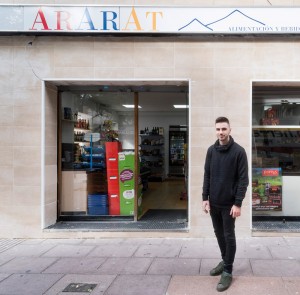
In the Porta neighbourhood in the Nou Barris district, Erik Melik-Stepanyan runs the Ararat, an establishment specialising in Armenian food products
Photo: Dani Codina
That tragedy is a “wound that hasn’t yet healed”, according to Sarkis Hakobyan, from the Armenia in Catalonia Association, located in Santa Coloma. “It survives within our homes, where we pass it on to our children so that they understand the importance of preserving their identity.” Erik Melik-Stepanyan’s parents scold him and his sister Elina if they hear them speaking in Spanish. “We understand them”, she admits, “because if we don’t speak Armenian, the coming generations won’t know it.” Erik is twenty years old and he runs a business in the Porta neighbourhood. Called Ararat, its shelves are full of wines and Armenian sauces, as well as canned, vinegary vegetables used to make tolma —ground mutton wrapped in grape or cabbage leaves— and khash, a soup whose main ingredient is cooked cows’ feet. Not far away, an Armenian mother and daughter from Tjumen (Russia) run a store in the Vilapicina neighbourhood, URSS-CCCP, which carries products from Nagorno-Karabakh —where they are originally from— along with candies, beer and cognac from Erevan.
Fleeing from an unsafe environment
“Not everything they say about over there is true”, Jorge Irias tells me soon after we introduce ourselves. “But almost”, he adds. Jorge is in charge of the massive festival organized at the end of the summer in the Poble Espanyol, attended by thousands of catrachos (Hondurans), who come together to celebrate their Independence Day. Much less well-attended but just as significant is the procession held every February 3 in Poble-sec in honour of the Virgin of Suyapa. A religious image leaves the headquarters of the Social Cultural Association of Culinary Art of Honduras and Friends in Catalonia on Carrer Murillo, and from there it is carried in a liturgical procession that ends up at El Sortidor Civic Centre. At this same civic centre, on Saturday over a hundred Honduran women and precisely four men gather to learn Catalan. This is the immigrant community that signs up most for the courses organized by the Centre de Normalització Lingüística.
Of the eight thousand Hondurans registered in Barcelona, 72.6% are women. Much more well-educated, they are the first to want to leave the unhealthy environment of Honduras, where there are high levels of school absenteeism and gangs and drug cartels do as they please, kidnapping, extorting and murdering. In 2016 there were 5,150 murders (4,680 of the victims were men), and the departments of Cortés and Atlántida —where Jorge is from— took the cake. He came over in 1984, in the middle of pre-Olympic fever, when the main problem in Honduras was the Contra (the counterrevolutionary Nicaraguan guerrilla, based in the neighbouring country). “I was an accountant”, he remembers, “I had never touched a brick.” Three decades later, he continues waterproofing rooves and renovating kitchens, bathrooms and façades. “Since I’ve been in Barcelona”, he explains, “three hundred families have come over.” Thanks to word of mouth, this community has continued to grow, becoming the most numerous immigrant community in seven of the thirteen neighbourhoods in the District of Nou Barris. It is also the community that presents the most requests for refugee status, which are generally granted within six months.
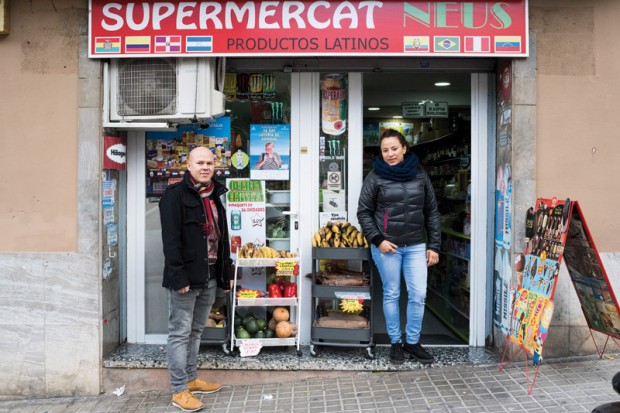
The Honduran Wilson Hernández and his Ecuadorian wife run a supermarket with a large offer in Latin-American products in the Verdum neighbourhood.
Photo: Dani Codina
In a coffee shop on Carrer Almansa in the Verdum neighbourhood where they sell espumillas (a traditional dessert from Honduras) I met Gabriela Padilla, just 26 years old, who cleans apartments because in Tegucigalpa, where she left her mother and son, it was impossible for her to find work. “I don’t have enough to bring them over”, she confesses. A little way up the street, Wilson Hernández and his Ecuadorian wife have a grocery with plenty of Honduran products: from camotes (a type of sweet potato) and patastillos (a tuber similar to the potato), to semitas (a sweet treat), tabletas de coco, blended frijoles, powdered corn and pineapple vinegar. He once worked at a textile company in San Pedro Sula (the industrial capital) and got tired of being robbed on Fridays, on payday.
At the bar of Zona Hondureña, in the Prosperitat neighbourhood, Gerson Miguel Hernández, who survives doing all manner of odd jobs, acknowledges that he’ll have to think twice before returning to his country. “When you’re told that one friend or another has been killed, it makes you not want to go back.” The owner of the restaurant, Adelmo Trejo, was about to lose his life three times. “And you know why? All because of a mobile phone” (he calls it a celular, as they’re known in Honduras). He tells me about it while his wife, Carla Cortés, prepares baleadas, catrachitas and carne asada for the diners who drink a tamarind refreshment while they wait.
According to Jorge, many Central Americans try to get into the United States, but get deported by the planeload. When this happens, Europe is the only alternative. They are Hondurans from Tegucigalpa, from industrial San Pedro Sula, Olancho… Some are blonde and light-skinned (from Santa Bárbara), dark-skinned Garifunas (from La Ceiba), Lencas (from Lempira) or Miskitos (from Cabo Gracias a Dios). And each and every one of them shares a single objective with the rest of the immigrants who have helped to transform our city: to make Barcelona their own.




